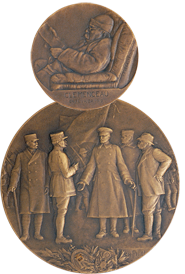
Harvard people with medals they aren’t sure what to do with have often given them to the University. Many of these impressions of history have fetched up in the Harvard College Library, specifically in Houghton, which is otherwise a repository for rare books and manuscripts. Leslie A. Morris, curator of modern books and manuscripts, keeps and shows students an accumulation of about 850 medals. Many of them were struck in the United States, but the gathering is cosmopolitan. The French medals on this page recall the role of that nation in the War to End All Wars.

 The piece at top, by the artist Jules-Prosper Legastelois, commemorates an early success, the Battle of the Marne (1914), with the spirit of France soaring over the troops on the reverse. The one at bottom, by Charles Pillet, honors the multitude who died in the tragic defense of Verdun. The large medal at right, from 1918 and also by Pillet, depicts General John J. “Black Jack” Pershing, who led the American Expeditionary Force. The medal second from the top appears to be an edition of one that was handmade for special presentation by the American Volunteer Motor-Ambulance Corps to its founder, Richard Norton, A.B. 1892, the son of Professor Charles Eliot Norton. The nesting storks are on a medal of Alsace; the small piece below it, from Tarbes, salutes the wounded of 1914; and the small medal at right is for the École Clemenceau, a school for orphans.
The piece at top, by the artist Jules-Prosper Legastelois, commemorates an early success, the Battle of the Marne (1914), with the spirit of France soaring over the troops on the reverse. The one at bottom, by Charles Pillet, honors the multitude who died in the tragic defense of Verdun. The large medal at right, from 1918 and also by Pillet, depicts General John J. “Black Jack” Pershing, who led the American Expeditionary Force. The medal second from the top appears to be an edition of one that was handmade for special presentation by the American Volunteer Motor-Ambulance Corps to its founder, Richard Norton, A.B. 1892, the son of Professor Charles Eliot Norton. The nesting storks are on a medal of Alsace; the small piece below it, from Tarbes, salutes the wounded of 1914; and the small medal at right is for the École Clemenceau, a school for orphans.

Alan M. Stahl, the curator of numismatics at Princeton’s Firestone Library, who is an expert on medals, calls these French examples “typical of the work of the time—a classicizing Beaux-Arts allegorical romanticism more appropriate for fin-de-siècle society celebrations than for World War I.” He prefers German medals of the period, which are “much more modern in style.”
Speaking of German memorabilia, a news piece in this magazine in 1920 noted that the French government had presented Harvard with a large collection of artifacts from the recent war—guns, bayonets, cavalry swords, gas masks, a flame thrower—on condition that the French material be “well separated from the German trophies in the exhibition room.” One wonders about the present whereabouts of that flame thrower.
 Photographs by Jim Harrison
Photographs by Jim Harrison







